 | Late accretion history of the terrestrial planets inferred from platinum stable isotopes Abstract: Late accretion of chondritic material to differentiated planetary bodies is thought to have been common in the early solar system. However, the timing and scale of admixing this material to terrestrial planets are poorly constrained. Using platinum (Pt) stable isotope data in a range of solar system bodies, we show that Earth’s post-Archean mantle has chondritic 198Pt/194Pt, consistent with addition of a chondritic late-veneer after core formation. Conversely, terrestrial Archean samples record non-chondritic, heavy, 198Pt/194Pt, indicating preservation of early mantle components that escaped complete mixing with the late-veneer. These data suggest admixing of ≤50 % of the eventual full late-veneer inventory. Such effective mixing within Earth’s mantle by 3.85 Ga is most consistent with modern-style plate tectonics. |
 | Direct sensing of total alkalinity profile in a stratified lake Abstract: We demonstrate the direct detection of a total alkalinity depth profile through the use of an integrated thin layer electrochemical modulation instrument which acts as an alkalinity sensor. The technique uses a chemically selective proton pump that alters the concentration of hydrogen ions in the thin layer sample. As the proton pump releases hydrogen ions the resulting pH is recorded at the pH probe placed directly opposite the thin sample gap. This results in an acid-base titration that takes place directly in the thin layer sample and therefore obviates the need for traditional sample manipulation. Collected samples from a stratified lake were assessed with this alkalinity probe to record a total alkalinity profile, indicating a substantial increase from 2.59 to 4.11 mM with depth. Results of the new method were in excellent agreement with titration alkalinity data, and offer the potential for autonomous on site measurements of this key parameter. |
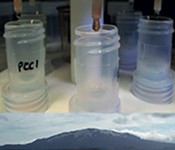 | Stable vanadium isotopes as a redox proxy in magmatic systems? Abstract: Recycling pathways of multivalent elements, that impact our understanding of diverse geological processes from ore formation to the rise of atmospheric oxygen, depend critically on the spatial and temporal variation of oxygen fugacity (fO2) in the Earth’s interior. Despite its importance, there is currently no consensus on the relative fO2 of the mantle source of mid-ocean ridge basalts compared to the sub-arc mantle, regions central to the mediation of crust-mantle mass balances. Here we present the first stable vanadium isotope measurements of arc lavas, complemented by non-arc lavas and two co-genetic suites of fractionating magmas, to explore the potential of V isotopes as a redox proxy. Vanadium isotopic compositions of arc and non-arc magmas with similar MgO overlap with one another. However, V isotopes display strikingly large, systematic variations of ~2 ‰ during magmatic differentiation in both arc and non-arc settings. Calculated bulk V Rayleigh fractionation factors (1000 lnαmin-melt of -0.4 to -0.5 ‰) are similar regardless of the oxidation state of the evolving magmatic system, which implies that V isotope fractionation is most influenced by differences in bonding environment between minerals and melt rather than changes in redox conditions. Thus, although subtle fO2 effects may be present, V isotopes are not a direct proxy for oxygen fugacity in magmatic systems. |
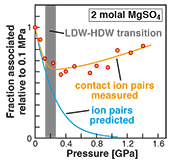 | Pressure-induced ion pairing in MgSO4 solutions: Implications for the oceans of icy worlds Abstract: At ambient temperature, liquid water transforms from a low-density to a high-density dynamic structure at ~0.2 GPa. The transition persists in electrolyte solutions; however, its effects on solute properties are unknown. We obtained Raman spectra of 0.5–2.0 molal MgSO4 solutions at 21 °C and 10-4 to ~1.6 GPa. Above about 0.4 GPa, we observed an increase in the MgSO4 contact ion pair abundance with pressure, regardless of concentration. This phenomenon contravenes the general rule that dissolved salts dissociate upon compression, and is likely caused by the structural collapse in the solvent with pressure due to increased hydrogen-bond breaking. Increasing ion association in high-pressure aqueous solutions implies that, at a given salinity, high-density water in deep, cold planetary oceans and pore waters will possess lower ionic strength and electric conductivity than previously thought. This behaviour will also lead to higher ocean salinity in the interiors of Pluto and the largest icy moons of Jupiter and Saturn, Ganymede, Callisto, and Titan, or in exoplanet water-worlds, through enhancement of submarine silicate weathering. |
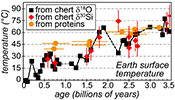 | Warm Archean oceans reconstructed from oxygen isotope composition of early-life remnants Abstract: Deciphering the surface conditions on the Earth during Archean times (> 2.5 billion years ago – Ga) is crucial to constrain the conditions that promoted the development of life. The progressive shift through time of the oxygen isotopic compositions of Precambrian siliceous sediments – the so-called cherts – has been interpreted as indicating a secular decrease of seawater temperature by 50-80 °C from the early Archean to the present-day. However, this interpretation has been questioned, notably because it assumes that the seawater oxygen isotopic composition has remained globally constant since 3.5 Ga, though this has never been tested by direct isotopic measurements on Archean samples. Here we report measurements of the oxygen isotopic composition of carbonaceous matter indigenous to Precambrian cherts up to ca. 3.5 Ga. These new results demonstrate that the oxygen isotope composition of seawater during most of the Precambrian remained around 0 ± 5 ‰, which is consistent with the composition of present day seawater. Combined with the chert oxygen isotope composition record, this indicates that ca. 3.5 Ga ago ocean bottom-water temperatures were ~50-60 °C higher than today. |
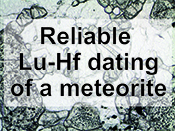 | The 176Lu-176Hf systematics of ALM-A: A sample of the recent Almahata Sitta meteorite fall Abstract: The application of Lu-Hf chronometry to meteorites has been compromised by arbitrary results such as dates up to 300 Myr older than the Pb-Pb age of the Solar System, unsubstantiated isochron scatter among different meteorite fractions, and varying initial Hf isotope ratios (176Hf/177Hfi). To determine the cause of the discrepancies and presence of unsupported radiogenic 176Hf, we collected Lu-Hf data for the ureilitic trachyandesite ALM-A, a fragment of the recent Almahata Sitta meteorite fall. The purest feldspar and pyroxene fractions and all 2 M HNO3 washes (i.e. selectively dissolved phosphate minerals) yield a 13-point isochron with a reasonable age of 4569 ± 24 Ma and 176Hf/177Hfi of 0.279796 ± 0.000011. Most impure mineral fractions, in contrast, scatter above this regression. Terrestrial contamination causes the 176Hf excesses, but is effectively removed by handpicking the purest mineral grains. Our study demonstrates 1) the successful application of the Lu-Hf chronometer to ALM-A, and 2) an internal consistency among the Pb-Pb age of the Solar System, the 176Lu decay constant, the Lu-Hf CHUR parameters, and robust estimates of the 176Hf/177Hfi of the Solar System from meteorites. |
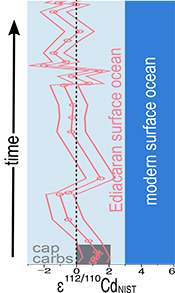 | Cadmium isotope variations in Neoproterozoic carbonates – A tracer of biologic production? Abstract: Cadmium concentrations and stable isotopic compositions in seawater are important tools for studying the biogeochemical cycling of Cd in the modern oceans and as a proxy for micronutrient utilisation by phytoplankton. It is now well established that Cd isotopes become “heavier” as the primary production in the surface ocean increases, even though the mechanism driving the isotopic fractionation is still debated. Here, we use this property of Cd isotopes to examine changes that took place in the oceans during the emergence of multicellular life in the Neoproterozoic. Isotopic compositions and concentrations of Cd, N and C are reported in shallow-water carbonates of Ediacaran age from the Xiaofenghe section on the Yangtze Platform, South China. The Cd isotope data - reported as ε112/110Cd - show positive excursions in the cap dolomites, while significantly lighter Cd is found in the overlying strata. After correction for salinity-controlled fractionation into inorganic calcite, calculated palaeo-seawater ε112/110Cdsw range from -2 to +1.5, overlapping values of modern surface seawater. Importantly, ε112/110Cdsw and δ13C show a general positive correlation, as would be expected in bio-productive environments. However, the trend to lighter ε112/110Cd up-section is not that explicitly expected for an “explosion of life” at the end of the Ediacaran. The upper Doushantuo also displays substantial fluctuations in REE abundances, δ15N and δ13C, which may be due to estuarine mixing. Our data suggest that the variations in ε112/110Cd are a result of biologically-induced fractionation in at least some of the Ediacaran carbonates at Xiaofenghe. Further Cd isotope fractionation processes are clearly playing a role as well, such as precipitation of sulphides under anoxic pore-water conditions and fractionation into inorganic carbonates under variable salinity conditions. These effects have to be evaluated carefully when using Cd isotope systematics in ancient marine carbonates to look for palaeo-productivity signals. |
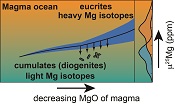 | Tracking the formation of magma oceans in the Solar System using stable magnesium isotopes Abstract: The processes associated with magma ocean formation and solidification can control the earliest compositional differentiation and volatile inventory of planetary bodies. Thus, elucidating the scale and extent to which magma oceans existed in the Solar System is critical for a full understanding of planet formation. Here we show that the magnesium isotope compositions of the co-magmatic diogenite and eucrite meteorites originating from the protoplanet Vesta are distinct and this is a predictable consequence of extensive crystallisation in a shallow magma ocean. The enrichment in the heavy magnesium isotopes observed in eucrites relative to diogenites is consistent with the isotopic differences measured between minerals and whole-rock basalts on Earth and other asteroids. This isotope effect is not readily observed on Earth due to the lower primary melt magnesium contents produced at smaller degrees of melting and less extensive amounts of mafic mineral crystallisation. However, it is discernible on other planetary bodies where magma oceans formed and crystallised and, thus, Mg isotopes provide a tracer of their previous existence. |
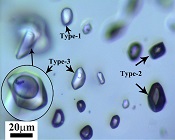 | Immiscible C-H-O fluids formed at subduction zone conditions Abstract: Earth’s long-term carbon cycle, which is regulated by subduction and volcanism, is critical for understanding Earth’s structure, dynamics, and climate change. However, the mechanisms for carbon mobility in subduction zones remain largely unresolved. Aqueous fluids produced by slab devolatilisation may dissolve a considerable amount of carbon, but it is usually assumed that aqueous C-H-O fluids in subduction zones are fully miscible. In order to constrain the nature of aqueous C-H-O fluids in subduction zones, experiments were performed at 0.2 to 2.5 GPa and 600 to 700 oC to study the phase relations of C-H-O fluids in the presence of 3 wt. % NaCl, using the synthetic fluid inclusion technique. The results show that at 0.2 GPa and 700 °C, one single C-H-O fluid phase was present; however, at 1.5 to 2.5 GPa and 600 to 700 oC, H2O and gases of CH4+H2, CH4+CO2, or CO2 coexisted as immiscible fluid phases. These results demonstrate that pressure can significantly expand the miscibility gap of C-H-O fluids and immiscible C-H-O fluids may occur in subduction zones. The likely occurrence of immiscible C-H-O fluids in subduction zones may cause extensive decarbonation and the formation of immiscible CO2-rich fluids, providing an important mechanism for the transfer of slab carbon to the mantle wedge. |
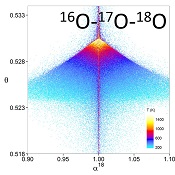 | The statistical mechanical basis of the triple isotope fractionation relationship Abstract: Multiple stable isotope relationships have found a growing variety of uses in geochemistry and cosmochemistry. Approximations to the statistical-mechanical models for predicting isotope effects have led to the notion that mass fractionation laws are constrained to a “canonical” range of possible values. Despite previous work indicating that these mass fractionation exponents can be highly variable, the concept of a constant relationship remains common. In this study, we demonstrate generically that the mass fractionation exponent, θ, can take any value for small fractionations and that these deviations are measurable. In addition, we characterise and advocate the use of the change/difference in cap-delta as a necessary and more reliable descriptor of multiple isotope fractionation relationships. Deviations from the “canonical” range are demonstrated by experimental data in the geochemically relevant haematite-water system. |
<< Previous issueNext issue >>





